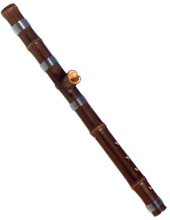
World Flutes Master

Take care of our enviroment

comprar

Peace web theme set courtesy of Crystal Cloud Graphics web set icon
Crystal Cloud Graphics
Crystal Cloud Graphics

Ji
It is a traverse bamboo wind instrument together with daeguem, junggum, sogeum and dangjeok. A U-shape mouthpiece is wedged into the blowhole, and the contact part is sealed with wax to prevent the leakage of air to generate sound. Its hole is shaped uniquely which is cut another blowpipe through the main blowpipe which is different from other equivalent blowpipes in its construction: the bolwpipe of the chi is combination of the two structures, the horizontally held the taegum and the vertically held instruments such as the tanso and t'ungso. In other word, it has two different functions which one is played in a horizontal way and the other is blown in a vertical way. In this respect, a newly added blowpipe is called a uich'i which means "a blowpipe attached to the newly made one". Its origin goes back to the past history of the Koguryo and Paekje period. Its reed is made of ssang'gol-chuk or whang-chuk, and its uich'i is made of haejuk which is a black colour from the shore of the sea. The ich's is firmly sealed by beeswax in order not to separate the two pieces. It has five holes which one hole is situated at beside the blowpipe and four other holes above.
It is a traverse bamboo wind instrument together with daeguem, junggum, sogeum and dangjeok. A U-shape mouthpiece is wedged into the blowhole, and the contact part is sealed with wax to prevent the leakage of air to generate sound. Its hole is shaped uniquely which is cut another blowpipe through the main blowpipe which is different from other equivalent blowpipes in its construction: the bolwpipe of the chi is combination of the two structures, the horizontally held the taegum and the vertically held instruments such as the tanso and t'ungso. In other word, it has two different functions which one is played in a horizontal way and the other is blown in a vertical way. In this respect, a newly added blowpipe is called a uich'i which means "a blowpipe attached to the newly made one". Its origin goes back to the past history of the Koguryo and Paekje period. Its reed is made of ssang'gol-chuk or whang-chuk, and its uich'i is made of haejuk which is a black colour from the shore of the sea. The ich's is firmly sealed by beeswax in order not to separate the two pieces. It has five holes which one hole is situated at beside the blowpipe and four other holes above.









